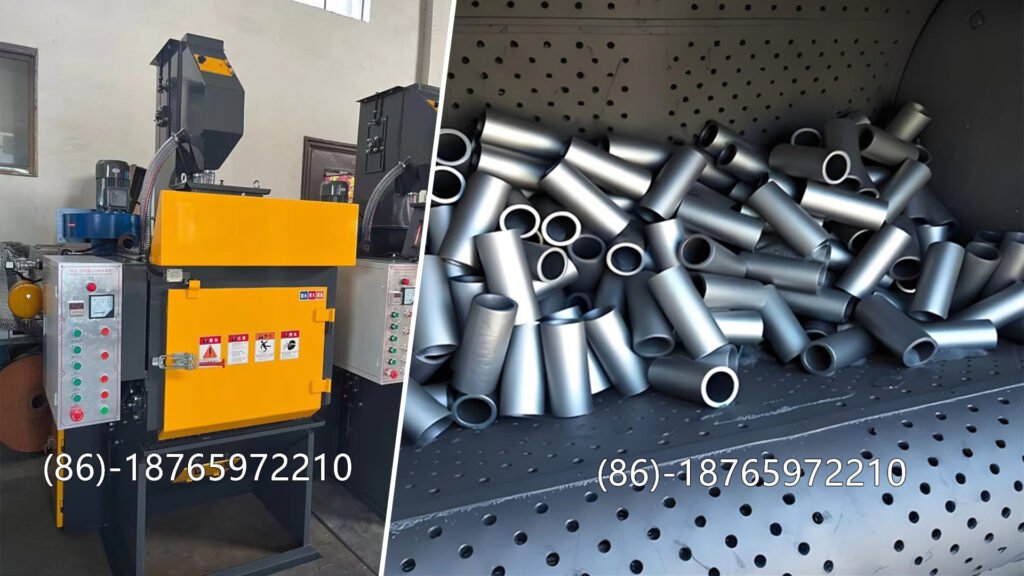From daily use in the workshop, one thing is clear: a tumble shot blasting machine will only perform well if it’s maintained properly. These machines take a lot of punishment—abrasive blasting, rotating drums, constant wear on liners and wheels. If we don’t stay on top of upkeep, breakdowns will hit production hard.
Points Follow In The Workshop to Keep The Machine In Good Condition
1. Daily Checks
- Listen to the machine: If there’s a new noise or extra vibration, something is loosening or wearing. Don’t ignore it.
- Inspect the belt or drum: Rubber belts can crack, steel link belts can wear. A damaged belt fails suddenly and causes downtime.
- Check abrasive circulation: Make sure shot is feeding smoothly. If it clogs, blasting efficiency drops right away.
2. Blast Wheel
The blast wheel does the real work.
- Keep it balanced: A wheel out of balance wears out bearings and throws abrasive unevenly.
- Change worn parts early: Blades, impellers, and control cages wear fast. If we wait too long, performance drops and other parts get damaged.
- Protective liners: The chamber liners are there to take the beating, not the housing. Replace liners before they wear through.
3. Abrasive Care
- Clean abrasive: Run the separator properly. Dust, sand, or broken shot in the mix just ruins efficiency and eats parts.
- Keep a good mix: Small, broken shot doesn’t hit hard enough. Always top up with fresh shot to maintain cutting power.
4. Dust Collector
- Check filters: A clogged filter kills suction, fills the chamber with dust, and creates a mess.
- Check ducts: Leaks or blockages reduce airflow and put strain on the system.
5. Moving Parts & Lubrication
- Bearings: Don’t skip greasing. Dry bearings are one of the most common failures.
- Chains and gears: Keep them aligned and tensioned. A worn sprocket or loose chain can stop the machine mid-shift.
- Seals: Leaking seals let abrasive escape and cause extra wear on places that shouldn’t be hit.
6. Electrical and Safety
- Emergency stops: Test them regularly. They must work when needed.
- Sensors and switches: Make sure interlocks work, so the machine doesn’t run with open doors or faults.
- Cables: Look for damage, especially near vibrating parts.
7. Planned Overhaul
Even with daily checks, we schedule downtime for bigger service:
- Replace blast wheel parts as a set, so wear is even.
- Inspect the chamber structure and loading system.
- Go through the dust collector, bearings, and seals completely.

FAQ – Tumble Shot Blasting Machine
1. What is a tumble shot blasting machine used for?
Tumble Shot Blasting Machine is used for cleaning, descaling, deburring, or surface preparation of small to medium-sized workpieces. Common parts include castings, forgings, automotive components, and hardware.
2. How does it work?
Parts are loaded into a rubber or steel link belt drum. As the drum rotates, the parts tumble over each other while high-speed abrasive shot from the blast wheel strikes them, cleaning all surfaces evenly.
3. What type of parts are suitable?
- Small to medium metal components
- Batch production parts up to around 40 kg each
- Workpieces that can withstand tumbling without deformation
Not suitable for very fragile, thin-walled, or large/heavy parts.
4. What abrasives can be used?
- Steel shot (for cleaning and strengthening)
- Steel grit (for descaling and surface roughening)
- Non-ferrous abrasives (aluminum oxide, etc., depending on material)
Choice depends on part material and required finish.
5. What are the main advantages?
- Handles large batches at once (high productivity)
- Consistent cleaning quality
- Low labor requirement once loaded
- Durable machine design for long service life
6. How often should maintenance be done?
- Daily: Check belt, blast wheel noise, abrasive flow, dust collector
- Weekly: Inspect wear parts (liners, blades, impellers)
- Scheduled: Replace high-wear parts together and overhaul bearings, seals, and dust collection
7. What are the common wear parts?
- Blast wheel blades, impeller, control cage
- Rubber or steel belt links
- Chamber liners
- Bearings and seals
8. How to extend machine life?
- Keep abrasive clean and properly graded
- Replace wear parts before they fail completely
- Maintain lubrication schedule
- Avoid overloading the drum with too many or too heavy parts
9. What safety precautions should operators follow?
- Never open doors while the machine is running
- Check that emergency stops and interlocks work
- Wear PPE (ear protection, dust mask if needed)
- Do not exceed rated load capacity
10. What industries commonly use tumble shot blasting machines?
- Foundries
- Automotive manufacturing
- Forging plants
- Hardware and tool making
- Small casting and machining shops
Final Note
Tumble shot blasting machine is tough, but not indestructible. If we keep to daily checks, replace wear parts on time, and treat maintenance as part of the production job—not as an afterthought—the machine will stay reliable, keep blasting clean, and avoid expensive downtime.

